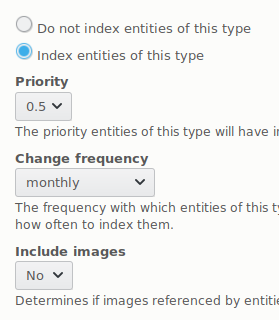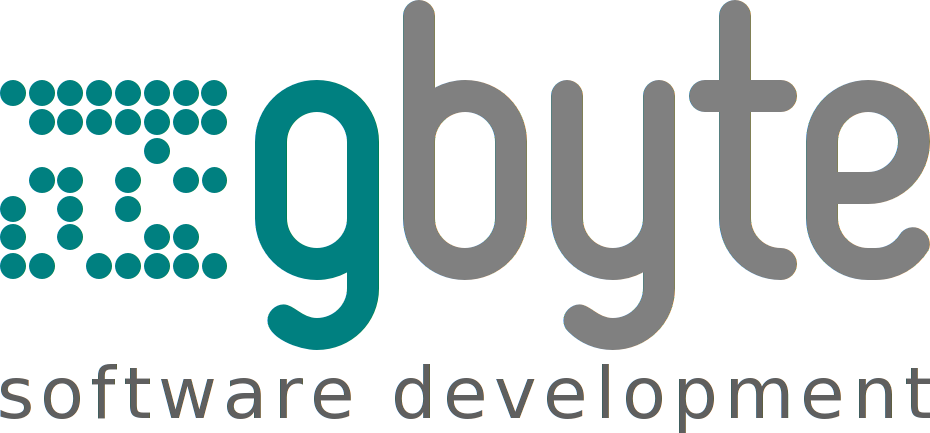
This is a technical description of the 2.x branch of the module. For the newer 3.x branch see this article; for 4.x, see this article.
New features of Simple XML sitemap
Version 2.10 of Simple XML sitemap is mainly a feature release with only a few minor bugs fixed. The new features are
- the implementation of the changefreq parameter
- the ability to set an interval at which to regenerate the sitemap
- the ability to customize XML output
- the ability to add arbitrary links to the sitemap
- image indexation
See the 8.x-2.10 release page for details.
A new version has been released, please make sure to visit the project page.
Image indexation
Simple XML sitemap is now able to create Google image sitemaps through indexing all images attached to entities. This includes images uploaded through the image field as well as inline images uploaded through the WYSIWYG. The inclusion of images can be set at the entity type and bundle level but can be overridden on a per-entity basis giving you all the flexibility.
Please bear in mind, that all images attached to entities get indexed regardless of their file system location (public/private). Another thing worth noting is that the original images get indexed, not the derived styles. This should be considered before indexing entities with many high resolution images which could increase traffic.
Indexation of custom link images has not made it into this release, but the feature is already available in the development version of the module.
Adding arbitrary links to the sitemap
Most use cases dictate the inclusion of internal links which can be achieved through adding entity links to the index. For non-entity pages like views, there has been the possibility to add custom links through the UI or the API. In both cases however the system only allows internal links which are accessible to anonymous users. The new version of the module provides a way to add any link to the index, even ones Drupal does not know about:
As the example shows, all properties of the link like priority/lastmod/changefreq can be defined as well.
To alter links shortly before they get transformed to XML output, there is still the possibility to use the following:
Basic alteration of the XML output
The following two new hooks can now be used to alter the XML output:
Other API changes
The API is now more forgiving allowing missing link setting arguments when using some of its inclusion altering methods. Here is en example of the simple_sitemap.generator API in action:
More documentation can be found here. I hope the new version of this module will be of great use to you!

Comments
One question, if you don't mind:
You say "add any link to the index, even ones Drupal does not know about", but then suggest using a hook. As a result, I'm a bit confused.
I use a directory on my website as a "personal Imgur" - i.e. upload images there through SFTP to post them somewhere, e.g. on forums.
That's the images "Drupal does not know about", but I would like to have them indexed, as the contents is usually rather interesting, unique and on topic (not like memes on Imgur).
What do I need to do to make Drupal include those images into sitemap? In most cases those images aren't displayed on my site (i.e. aren't used in the contents of any node).
Thanks,
Dmitri
Usually you would not index images by themselves, instead you would index images as part of a webpage. For this page, it looks like this:
So if you have an accessible index page of these images, you can use hook_simple_sitemap_arbitrary_links_alter to add that page and its images like shown above, or, if it is a routed page, just add it to the index and use hook_simple_sitemap_links_alter to add images to it.
But if you are serious about the image drop functionality, the best thing would be to build this functionality in a way which makes Drupal know the images. I implemented this functionality on gbyte.co to share documents and images with my clients. There is some custom code involved, but most of the work is done by these modules:
ACL and Content Access handle the permissions, Download makes it possible to download all the files attached to an entity. I also implemented group accounts where many people can use the same credentials to log in to their files. To prevent them from editing the account, the User Protect module can be utilized.
I would like to know exactly xml sitemaps works. I am also the developer of .net but I am confused with xml things how it works exactly
Not sure how to respond to that. XML is a markup language for storing data in structured text. I would advise you to check out w3schools.com and go through some youtube videos.
Thanks for the information.
Can anyone suggest me how to add extra elements to sitemap? For example: I want to add an additional element name inside the tag
This is possible with the 8.x-3.x branch.
The easiest way to do it would be to implement your own sitemap generator plugin by extending Drupal\simple_sitemap\Plugin\simple_sitemap\SitemapGenerator\DefaultSitemapGenerator. You can then tweak the sitemap structure to your liking.
If you need URLs to also inject different data into the sitemap structure, implement a UrlGenerator plugin by extending the various URL generators, like Drupal\simple_sitemap\Plugin\simple_sitemap\UrlGenerator\EntityUrlGenerator.
In order to replace the old sitemap and URL generator plugins with the new ones, either use the API method to alter the default or add a new sitemap type definition:
... or use some hooks to alter the definition at runtime as this API example exemplifies:
Hit me with any questions you might have. I will be publishing a blog post about all new features of 8.x-3.1 as soon as 3.1 arrives.
How use Simple XML sitemap to generate automatically sitemap.xml with pages generated by views?
I know that I can use UI and add it manually, but it's little annoying when the pages often changing.
Thanks Pawel. I will check this.
Moreover is there a way to generate different sitemap for each domain.
Generally the sitemap will show all the urls of different langauge like english, french, chinese. Whereas my client wants to show only english urls on english domain and chinese urls on chinese domain.
Note : Its not a multisite. Its a multilingual site.
@Deepika The primary function of this module is to generate sitemaps according to the new Google so-called hreflang standard. AFAIK hreflang sitemaps should be understood by all major search engines. You need to tell your client. :)
But with 3.x there is nothing stopping you from writing your own sitemap type by writing your own stiemap and url generator. Then you could add say 3 sitemap variatns of that new type which you would name after langauages. This could be done dynamically via a hook to automatically determine active languages. There you go, you have a traditional sitemap.
An easier approach would be to use xmlsitemap which generates sitemaps according to the older standards, but I haven't been able to use that module because of its unfinished/buggy state.
@Tomasz Is your intent to generate a sitemap which holds links to your views pages? Or do you mean links to entities from views results?
If it is the former, there is no automated way of adding all views, but
I don't know how to generate list with all links generated by views and use it with API or other functions, but I've found PHP script: https://www.plop.at/en/xml-sitemap.html What do You think? Is it good way?
I don't think that a script that simple could rival the integration the Drupal module provides. But why not just try it?
So you want to generate an XML sitemap with links taken from views results?
In this case I would write a URL generator plugin for simple_sitemap that loads the views' results programmatically. If you wish support with this feature, drop me a line through the contact page so we can discuss privately.
Is it possible with current version of simple sitemap module because 8.x-3.x branch is still under development we can't use it currently on our site.
@Deepika The stable branch is also in development. I woudn't worry too much about the dev tag, it will be tagged stable soon.
No, it is not possible to do such things with 2.x.
Add new comment